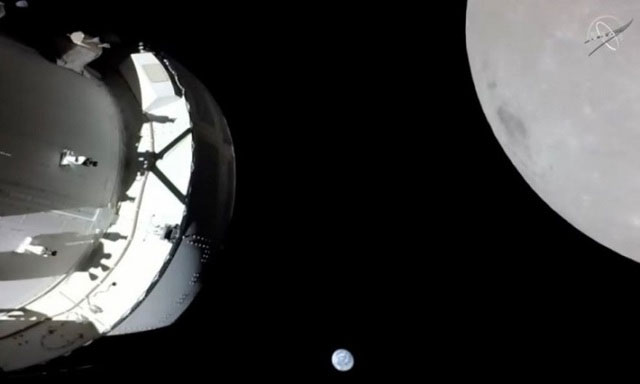NASA Recently Lost Contact with Orion During the Billion-Dollar Artemis 1 Mission, and the Cause is Still Unknown.
After successfully launching to the Moon on November 16 as part of NASA’s Artemis 1 mission, the Orion spacecraft was operating well. However, on November 23, mission controllers for Artemis 1 lost contact with Orion at 1:09 PM (Vietnam time). This incident occurred while re-establishing the communication link between Orion and the deep space network, which is the radio dish network NASA uses to exchange data with spacecraft.
NASA stated: “The reconfiguration has been successfully completed several times over the past few days, and the team of experts is investigating the cause of the signal loss. The team has also resolved the issue through ground reconfiguration. Engineers are reviewing data from the incident to determine what happened. Meanwhile, specialists are downloading data recorded on the Orion spacecraft during the communication loss.”
The communication loss with Orion lasted for 47 minutes. According to NASA, the Orion spacecraft remains in good condition and was not adversely affected by this incident.
Orion is currently preparing for a critical maneuver. The spacecraft is scheduled to perform a burn on November 25 to enter orbit around the Moon. If all goes well, it will remain in lunar orbit for about a week before beginning its return to Earth on December 1.
As planned, Orion will re-enter Earth’s atmosphere at a speed of 40,000 km/h. This will also be a significant test for the spacecraft’s capsule and heat shield, which must endure temperatures of up to 2,750 degrees Celsius. NASA’s spacecraft will land by parachute in the Pacific Ocean, concluding the Artemis 1 mission.
Artemis 1 is the first journey of NASA’s Orion spacecraft and Space Launch System (SLS) rocket. SLS is the most powerful rocket ever successfully flown by NASA. This duo is expected to carry astronauts for the first time in 2024 during the Artemis 2 mission, which will orbit the Moon.
The Artemis 3 mission will follow a year later. This flight will take astronauts near the Moon’s south pole, where NASA aims to establish a crewed base. This is also one of the primary missions in the agency’s Artemis program.
Moments of Orion Capturing Images of Earth
Just hours after a successful launch, Orion also conducted a self-portrait while flying in space, sending back low-resolution images of Earth. The images from the ground, Earth’s atmosphere, and space are used to assess the technical success of the Artemis 1 mission. From there, NASA aims to return humans to the Moon as early as the middle of this decade.
NASA also recently shared a new video of the Orion spacecraft capturing images of Earth while flying close to the Moon’s surface.
On November 21, Orion achieved a significant milestone by performing a burn to enter lunar orbit.
The video was recorded on November 21 after Orion re-established contact with NASA’s deep space network.
During a live broadcast of Orion’s flight around the Moon, NASA spokesperson Sandra Jones noted that the spacecraft was then flying 373,000 km from Earth.
Thus, the high-definition images of Orion are considered to far exceed the previous images of the blue planet. This imagery also evokes memories of the Apollo 8 flight (December 24, 1968), when astronaut Bill Anders captured a photo of Earth rising behind the Moon.
Additionally, NASA’s Voyager 1 spacecraft has previously taken images from above the plane of the solar system and beyond Neptune’s orbit.

Orion spacecraft captures images of the Moon and Earth during the November 21 flyby. (Photo: NASA).
As of 7:44 PM on November 21 (Vietnam time), Orion was gliding past the Moon’s surface at a distance of 130 km. The spacecraft is set to continue into lunar orbit until November 25.
On November 25, the Orion spacecraft will enter a distant retrograde orbit (DRO), with a stable trajectory approximately 64,000 km from the Moon’s surface (until December 1) before returning to Earth.
According to NASA’s spokesperson: “This orbit is very different from the one used during the Apollo program, where the crewed spacecraft flew closer to the Moon in a circular path. This distant retrograde orbit is also crucial as it helps us explore how the spacecraft operates in the deep space environment.”


















































